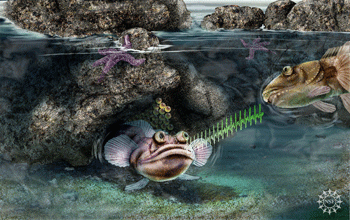Multimedia Gallery
Origin of Vertebrate Sound
An artist's representation shows the midshipman fish singing to attract a mate.
Researchers mapped developing brain cells in newly hatched midshipman fish larvae and compared them to those of other species and found that the neural network behind sound production in vertebrates can be traced back through evolutionary time to an era long before the first animals ventured onto dry land. The neural circuitry that enables human beings to verbally communicate--and birds to sing and frogs to ribbit--was likely laid down hundreds of millions of years ago with the hums and grunts of fish.
This image accompanied NSF press release, "Sorry, Charlie, You and Nemo Aren't the Only Fish That Talk."
Credit: Nicolle Rager Fuller, National Science Foundation
See other images like this on your iPhone or iPad download NSF Science Zone on the Apple App Store.
Images and other media in the National Science Foundation Multimedia Gallery are available for use in print and electronic material by NSF employees, members of the media, university staff, teachers and the general public. All media in the gallery are intended for personal, educational and nonprofit/non-commercial use only.
Images credited to the National Science Foundation, a federal agency, are in the public domain. The images were created by employees of the United States Government as part of their official duties or prepared by contractors as "works for hire" for NSF. You may freely use NSF-credited images and, at your discretion, credit NSF with a "Courtesy: National Science Foundation" notation.
Additional information about general usage can be found in Conditions.
Also Available:
Download the high-resolution JPG version of the image. (984 KB)
Use your mouse to right-click (Mac users may need to Ctrl-click) the link above and choose the option that will save the file or target to your computer.

